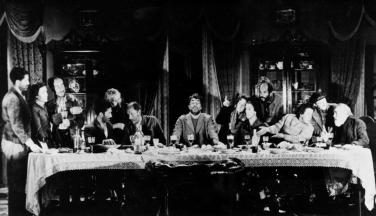The season dedicated to Luis Buñuel which is being held throughout the year 2021 at TBK, within the Nosferatu programme, will reach its end in December. An exciting season that has explored the complete works by the filmmaker from Calanda in chronological order and which has enabled spectators to return to a big screen to watch classics from his filmography and undoubtedly discover less well-known titles.
This autumn the retrospective continues with one of his most important films, Viridiana (1961), almost unanimously considered of the best Spanish films ever, as it precisely meant the return of the filmmaker from Calanda to his country of origin to shoot a film after being away for almost thirty years. He returned thanks to the efforts of, among others, Ricardo Muñoz Suay and Pere Portabella, who after lengthy negotiations with the authorities managed to get Luis to film again in Spain. He does so, and the rest is history (or legend): the back and forth with censors, Lola Gaos and the last supper, the Palme d'Or at Cannes, the card game and prohibition.
Back in Mexico he filmed two more classics, The Exterminating Angel (1962) and Simon of the Desert (1965), stories of trapped characters: a group of people inside a house they cannot escape from, and a stylite who, through his own decision in this case, decides to stay atop a column for the rest of his life.
The season continues with a new return, this time to France. Le Journal d’une femme de chambre (1963) marks the beginning of Buñuel’s collaboration with screenwriter Jean-Claude Carrière, becoming very close from then on (they even wrote his highly recommendable memoir together, Mi último suspiro), this time adapting the novel of the same name by Octave Mirbeau that had already been filmed by Jean Renoir a few years earlier.
Buñuel and Carrière then transferred to the big screen Belle de Jour (1966), the novel by Joseph Kessel, with the invaluable collaboration of Catherine Deneuve as Sévérine, a middle-class woman bored of her monotonous life who starts to lead a double life.
La Voie Lactée (1969) narrates the journey of two pilgrims from Paris to Santiago de Compostela during which they meet a number of characters who enable Buñuel to reflect and debate with much humour the dogmas of Christianity which, as he always pointed out, had so much influence (to his regret) on his life and work: “The two experiences that have had the most profound impact on my life are my stay with the Jesuits (the biggest limitation) and my membership of the Surrealist group (the biggest freedom). My life has played out under the shadow of this conflict”.
Nine years after Viridiana, Buñuel returned to Spain to film Tristana (1970), again adapting Benito Pérez Galdós. Next would come one of the high points of his filmmaking, Le Charme discret de la bourgeoisie (1972); awarded all over the world, this surreal, hilarious and unclassifiable story featuring a group of picturesque characters who just want to eat their supper. Le Fantôme de la liberté (1974) is a historical fresco about freedom, communism and artistic creation that starts with the assault by Napoleon's troops on Toledo in 1808, and continues until the present day (back then).
The retrospective journey through the works of the maestro from Calanda ends in 1977 with Cet obscur objet du désir (1977), a story of love and heartbreak across several European cities between Matthieu, a French gentleman portrayed by Fernando Rey, and the Spanish girl Conchita (played interchangeably by Carole Bouquet and Ángela Molina).
The season has been completed throughout the year with a handful of films related (in a variety of ways) to Buñuel's work. Four titles will be screened in autumn in this Buñuel + Plus space, starting with Marquis (1989), by Henri Xhonneux, an animation film that approaches the universe of the Marquis de Sade. And one of the most important European animation directors of the 20th century, Jan Švankmajer, will visit the screens of TBK this autumn with Conspirators of Pleasure (Spiklenci slasti, 1996), an extraordinary film (this time live action) about fantasy and pleasure.
These pluses will conclude in December with the screening of 4 (2005), the directorial début by Russian filmmaker Ilya Khrzhanovsky, and The Love Witch (2016), an elegant and fun film about witchcraft from a feminist perspective written, directed and produced by Anna Biller.
Without a doubt, 2021 has been a Buñuel year at TBK. The complete works of one of the greats have been shown on its big screen and that's how it will be remembered.

